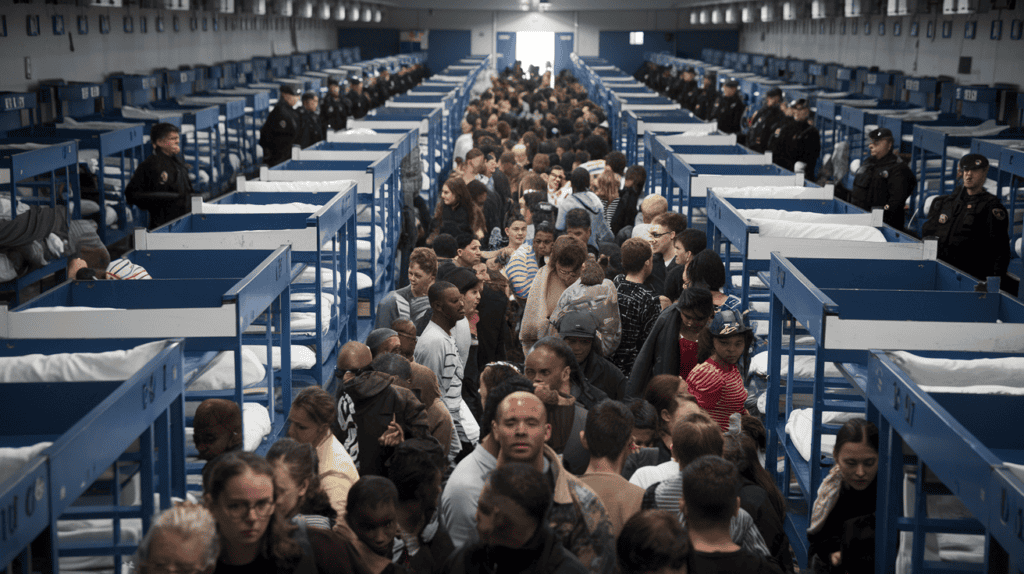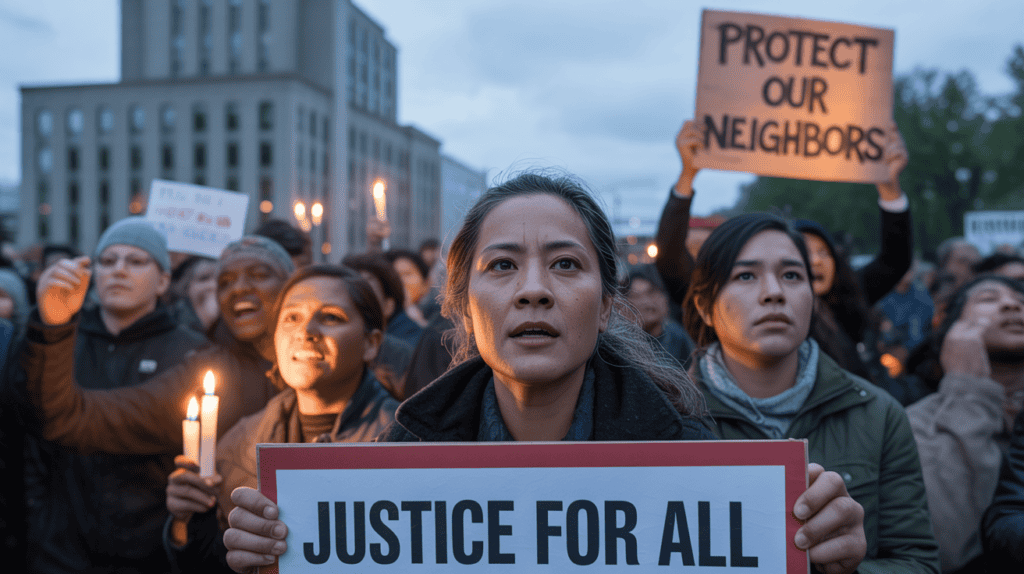Snapshot of a System Under Strain
Picture a fleet of black SUVs rolling through quiet neighborhoods before sunrise. Their tinted windows hide agents scribbling on clipboards, radios crackling in low voices.
This isn’t a movie. It’s another day for Immigration and Customs Enforcement (ICE), whose agents now face pressure from the Trump administration to meet an ambitious daily arrest quota.
The administration’s recent directive sets a goal: arrest 3,000 undocumented immigrants every single day. Agents wonder, Who’s next? Who’s safe?
An Evolving Approach to Immigration Enforcement
Immigration enforcement isn’t new. The scale and speed of current policies, however, feel unprecedented.
ICE, under the watchful eyes of the White House and the Department of Homeland Security (DHS), leads a national campaign. The agency must deliver on promises of mass deportation and tighter borders.
Here’s a snapshot of that approach:
| Tactic | Description |
|---|---|
| Daily Arrest Targets | Agents must log 3,000 arrests per day, a sharp increase from previous years. |
| Cross-Agency Involvement | Federal agencies like the FBI and DEA now redirect resources to support ICE operations. |
| Expanded Locations | Arrests are taking place in previously protected areas such as courthouses and even school zones. |
| Local Police Deputizing | State and local officers are being brought in under programs like 287(g) to extend ICE’s reach. |
These methods shift how immigration law intersects with daily life. Regular people, sometimes with decades in the United States, now live with uncertainty as routine destinations become potential sites for arrest.

The Numbers Tell a Striking Story
The numbers are clear. On a given Thursday, ICE officers may arrest dozens on small islands like Nantucket, moving them out via Coast Guard vessels while neighbors look on, stunned.
Detention centers fill rapidly. By mid-May, more than 49,000 people found themselves in custody—crowding local jails and repurposed federal facilities.
Notable stats:
- 3,000+ arrests demanded daily
- 1 million+ arrested annually if quotas are met
- 49,000 detainees reported in ICE custody in May
Overcrowded detention centers, case backlogs, and a legal system scrambling to adjust have become the new normal. Some judges now dismiss asylum claims without a hearing, adding emotional toll to an already complex crisis.
Who’s Caught in the Net?
The administration justifies these actions with public safety and national security, focusing on the removal of “criminal aliens.” In practice, those swept up in ICE raids are a varied group.
- Some have criminal records, but others are parents, workers, or students with no history of violence or crime.
- Mass arrests don’t only target those with criminal backgrounds. Individuals and families can be arrested at home, work, school, or immediately after court hearings—even when they try to comply with U.S. immigration law.
This strategy makes everyday life feel fraught with fear for many:
- A routine traffic stop or an early-morning school run might trigger a chain of events leading to detention.
- Even routine participation in legal proceedings—court dates for traffic tickets, probation check-ins—now carries risk.
Table: Who’s Being Targeted?
| Group | Risk Scenario |
|---|---|
| Undocumented Families | Arrested at home, schools, workplaces |
| Longtime Residents | Caught in sweeps despite ties to communities |
| Non-citizen Defendants | Targeted at courthouses after hearings |
| Asylum Seekers | Deny hearings and remove summarily |

Changes Felt Everywhere: From Courtrooms to Coastlines
Certain places no longer feel out-of-bounds for federal agents. The courthouse, once seen as sacred ground for due process, now functions as a staging ground for ICE.
Agents linger in hallways, ready to make arrests in full view of other families, attorneys, and judges. On remote coastlines, rapid raids force small communities to grapple with emotional fallout—fear, anger, confusion.
The blending of law enforcement agencies—FBI, DEA, ATF—into immigration crackdowns has brought unexpected ripple effects. With national security resources redirected, investigations related to drugs, violence, or terrorism face delays or deprioritization.
Federal agents who once targeted major criminal enterprises now find themselves assigned to immigration duty, prompting frustration inside the ranks.
The Human and Legal Dimensions
Supporters of these policies argue they’ll make the country safer by prioritizing the removal of dangerous individuals, particularly gang members and those with serious convictions. Civil rights advocates, lawyers, and some judges express concern for due process and equal protection.
Potential legal and ethical issues:
- Due process concerns: Arrests at courthouses and speedier case dismissals cut corners on legal rights
- Civil rights violations: Residents allege they’re targeted on the basis of appearance, accent, or ideology
- Overcrowding and detention: The uptick in detainees has led to unsanitary, overcrowded conditions
Some local law enforcement agencies refuse to participate, citing strained community relations and resource limitations. Others, deputized under ICE’s programs, now carry out federal immigration work in tandem with their traditional duties.
Funding the Crackdown
An enforcement surge of this magnitude demands resources. Federal contracts for private prison space have soared, drawing scrutiny over ties between top officials and the companies profiting from the crisis.
Congressional spending bills push billions more into ICE and border enforcement, at the expense, some argue, of fundamental public services.
Here’s a breakdown of where resources are going:
| Spending Category | Estimated Increase | Impact |
|---|---|---|
| Private Detention | Hundreds of millions | Expanded capacity, but overcrowding persists |
| Federal Law Enforcement | Reallocation of agents | Less focus on other national security priorities |
| Legal System | Streamlined cases, expedited removals | Risk of errors and rights violations |
A Widening Gap Between Policy and Public Opinion

For many Americans, these hardline measures feel overwhelming. National polls show support for broad crackdowns cooling as communities experience the effects—absent classmates, missing coworkers, families shattered overnight.
Immigration enforcement used to conjure images of shadowy smugglers or menacing criminals. Now, the faces behind the statistics often belong to neighbors, friends, or familiar figures at the local grocery store.
Quick list: Community responses
- Neighborhood advocacy groups organize legal aid and safe spaces
- Schools and churches provide sanctuary and support
- Local governments debate whether to assist or resist federal operations
The Emotional Weight Carried by Agents and Immigrants
Even ICE agents feel conflicted. Many joined to target violent criminals or national security threats, but now carry out mass arrests for administrative violations.
The stress builds—agents face burnout, frustration, and pushback from families who see their loved ones swept into detention. For immigrants and their children, anxiety is a daily companion.
Kids worry about disappearing parents. Communities grieve as essential workers vanish overnight.
While policies are debated in Washington, real effects ripple through kitchens, classrooms, and late-night phone calls filled with whispered fears.
Shifting Leadership and Uncertain Direction
Pressure mounts at the top. Senior ICE officials are ousted or reassigned as the administration demands greater “results.”
Leadership churn, mixed messages, and secrecy breed distrust inside the agency and among the public. Policy priorities arrive quickly, and agents on the ground scramble to adapt.
Key points of uncertainty:
- Leadership changes leave local offices guessing about priorities
- Rumors of further increases in quotas spark anxiety and confusion
- Rapid shifts erode morale among field agents and commanders alike

Final Thoughts on an Escalating Landscape
The tension between enforcement goals and the practical realities of U.S. immigration law is more pronounced than ever.
Each day’s numbers are not just data points; they’re human stories, filled with uncertainty and marked by the ever-present fear of the next knock at the door.
Quick Facts at a Glance
| Topic | Current Situation |
|---|---|
| Daily ICE Arrest Quota | 3,000 minimum—triple earlier expectations |
| Largest Raids | Courthouses, small islands, urban centers |
| Detention Population | Over 49,000 and growing |
| Enforcement Support | FBI, DEA, ATF, local police all contributing |
| Public Reaction | Rising anxiety, protests, shifting opinions |
This period brings urgency and confusion. Uncertainty lingers just beneath the surface—one arrest at a time.
Where do you stand on this? Is Trump making the right moves, or do you think he’s gone too far? Let us know in the comments below!







